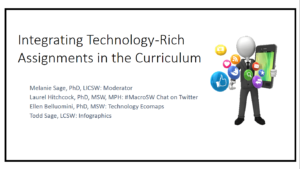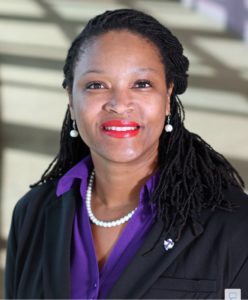FERPA & Social Media: Thoughts for Social Work Education
 What about FERPA? This is one of the most common questions I hear when presenting about using social media in the classroom. FERPA, the Family Educational Rights and Privacy Act, is the US federal law that protects the privacy of students’ educational record, and ensures that students have some control over their records. Examples of what is included in an educational record at the post-secondary level include grades, transcripts, class lists, student course schedules, and student financial information. Social work educators are often very aware of privacy and disclosure of personally identifiable information because of our practice backgrounds and the NASW Code of Ethics, so FERPA makes sense to us. It is understood that we should abide by FERPA and our professional standards of privacy and informed consent while modelling appropriate ethical standards for our students. However, this does not mean that social media is off-limits as an educational and professional development tool (Drake, 2014). Rather it means that as social work educators, we can use social media with students as long as we do so in ethical and legal ways (Rodriguez, 2011).
What about FERPA? This is one of the most common questions I hear when presenting about using social media in the classroom. FERPA, the Family Educational Rights and Privacy Act, is the US federal law that protects the privacy of students’ educational record, and ensures that students have some control over their records. Examples of what is included in an educational record at the post-secondary level include grades, transcripts, class lists, student course schedules, and student financial information. Social work educators are often very aware of privacy and disclosure of personally identifiable information because of our practice backgrounds and the NASW Code of Ethics, so FERPA makes sense to us. It is understood that we should abide by FERPA and our professional standards of privacy and informed consent while modelling appropriate ethical standards for our students. However, this does not mean that social media is off-limits as an educational and professional development tool (Drake, 2014). Rather it means that as social work educators, we can use social media with students as long as we do so in ethical and legal ways (Rodriguez, 2011).
The purpose of this post is to provide some examples and best practices for FERPA-compliant social media assignments based on my understanding and experiences, and insights from colleagues. As with any ethical challenge, there are no black or white answers, but it is my hope that information in this post will provide insight on how social work educators can embrace the benefits of social media assignments while being mindful of the risks. And there are many benefits to using social media as social workers such as contributing to public conversations, building relationships with other practitioners, and staying current on news and research. Further, helping social work students develop the values and skills to professionally and ethically use social media is included in Council of Social Work Education’s 2015 Educational Policy and Accreditation Standards.
Here are ways I work to ensure that I am being ethical and professional with social media in the classroom:
Day Two of #SWDE2017 – Integrating Technology-rich Assignments in the Curriculum
 From April 12-14, 2017, the third annual Social Work Distance Education Conference was sponsored by Our Lady of the Lake University’s Worden School of Social Service in San Antonio, TX.
From April 12-14, 2017, the third annual Social Work Distance Education Conference was sponsored by Our Lady of the Lake University’s Worden School of Social Service in San Antonio, TX.
Melanie Sage & Todd Sage of the University of North Dakota, Ellen Belluomini of Dominican University, and I participated in a panel discussion about incorporating technology-based assignments in the social social work curriculum. We talked about three different types of technology-based assignments that can be incorporated into almost any classroom: Twitter Chats, Technology Assessments, and Infographics.
You can access a copy of the slides here: https://www.slideshare.net/laurelhitchcock/integrating-technologyrich-assignments-in-the-curriculum. We also have some assignment specific resources:
#BPDNOLA17 – Visualizing Data: Infographic Assignments across the Social Work Curriculum
 Today is the third day (Friday, March 3rd) of #BPDNOLA17, and I am presenting with some of my favorite #swtech peeps, Dr. Nathalie Jones of Tarleton State University and Dr. Melanie Sage of the University of North Dakota, at 1:45pm in Bayside C at the Sheraton in New Orleans. We will be talking about an infographic assignment that we jointly developed and implemented with students at each of our campuses. The use of infographics for classroom assignments is becoming commonplace in higher education, although less is known about its use in social work education. Our workshop will review how we collaborated to develop, implement and evaluate an infographic assignment for courses across the social work curriculum.
Today is the third day (Friday, March 3rd) of #BPDNOLA17, and I am presenting with some of my favorite #swtech peeps, Dr. Nathalie Jones of Tarleton State University and Dr. Melanie Sage of the University of North Dakota, at 1:45pm in Bayside C at the Sheraton in New Orleans. We will be talking about an infographic assignment that we jointly developed and implemented with students at each of our campuses. The use of infographics for classroom assignments is becoming commonplace in higher education, although less is known about its use in social work education. Our workshop will review how we collaborated to develop, implement and evaluate an infographic assignment for courses across the social work curriculum.
Teaching with Infographics: My experiences with digital literacy and non-traditional students
Nathalie P. Jones, PhD, MSW is an Assistant Professor of Social Work at Tarleton State University. In this blog post, Dr. Jones writes about her experiences creating and implementing an infographic assignment with nontraditional social work students.
As an Assistant Professor of Social Work at Tarleton State University, I have absolutely enjoyed educating social work students on the use of technology through macro social work practice courses. I teach a large number of non-traditional learners (those who have been out of school for longer than one year, and are employed, parenting, or in any other roles that are competing with being a learner as defined by the National Center for Education Statistics [2015]). I find that they develop student groups quickly in order to have support while working on assignments, especially those assignments that include the use of digital technology.
To help my students improve their understanding of digital and social technology, I have introduced the use of infographics during an advanced social work course entitled Women’s Issues. Infographics are visual representations of almost any type of information. Infographics are similar to storytelling with visual content and supported with statistical data. They are an effective way to communicate large amounts of information in a clear and succinct way, and are an increasingly popular tool in popular media and the non-profit world (NonProfit Tech for Good, 2014). Understanding how to create, share and evaluate infographics is a key digital literacy skill for social workers (Shelly, 2015). Along with all these benefits, I wanted to create an assignment that was fun and engaging for my nontraditional students who are often nervous about nontraditional, digital assignments.
For the Women’s Issues course, I asked students to research an issue or social problem affecting women, turn that research into an infographic (rather than a written paper), and then share their infographics with professionals outside of the class as a way to network with alliances who advocate on behalf of women. This meant students needed to not only create a quality artifact for a grade, but also learn how to share it with other advocates in a public way – via social media. In an effort to support learners who were experiencing technology in college for the first time, I provided them with seven detailed steps to successfully complete the infographic assignment. These steps involved learning about Twitter as well as creating an infographic.
Here are the assignment steps directly from the course syllabus:
Step 1: Create a Twitter Account & provide your Twitter Handle. *Don’t forget to follow the instructor.
Step 2: Research & provide a resource of two infographics (1) from the web and (1) from Twitter related to Women’s Issues. Then, provide a 1-2 page comparison on how the infographic was distributed, what was learned & why this is a resource for issues related to women.
The Shared Case Study: An online activity for Interprofessional Teamwork
Natalie Curry, LCSW is a Clinical Instructor at Missouri State University’s (MSU) School of Social Work. She has been on the faculty with MSU for two years and prior to that was an adjunct instructor for MSU, Drury University, and Washington University in St. Louis. Prior to entering academia, her practice background includes working with individuals who were homeless in various capacities, inpatient psychiatric care, and behavioral health consulting in primary care. In this post, she writes about an online, interprofessional learning activity that she helped to develop and implement with colleagues at MSU You can follow Natalie on Twitter at @natalielcsw.
Last fall, there was considerable interest around interprofessional education in the College of Health and Human Services (CHHS) at Missouri State University (MSU), where I work. My colleagues and I believed that we were doing well at talking with our students about how much collaboration they would do in their careers with other healthcare professionals. But we wanted to go further and figure out ways to provide the students real opportunities for interprofessional practice in their educational programs. That was part of the motivation for bringing together faculty from all 11 disciplines (such as social work, nursing, medicine and others) within CHHS, in addition to the University of Missouri-Kansas City School of Pharmacy which was already in partnership with MSU. The other part of motivation was a growing recognition that interprofessional activities were no longer just encouraged in many of our disciplines’ accreditation standards; they were required.
Starting in Fall 2015, our committee to begin developing interprofessional educational activities for our students. We met monthly and eventually decided that it was not feasible to develop one activity, project, or experience that all students from CHHS could do together and still be meaningful. We decided on four “menu items” that each discipline could choose to participate in, depending on the needs of their students. We wanted to have a mix of interprofessional activities, ranging from one-day experiences to projects that could be implemented over the course of a semester.
Review of Teaching & Learning in Social Work Blog Posts for 2016
 The end of a year is a natural time for reflection, and this year I offer a review of all the posts that appeared on Teaching & Learning in Social Work Education during 2016. My goal for this blog is to write or publish at least two posts a month, which happened more months than not. I also recruited other social work educators to write about their own experiences in the classroom or with scholarship, and also write about about all of my presentations, either at conferences or as a part of a workshop. This year, I published a total of 25 blog posts, representing work with numerous collaborators and good colleagues. Below is a list of this year’s post grouped around the topics of assignments, projects, guest educator posts, and conference presentations.
The end of a year is a natural time for reflection, and this year I offer a review of all the posts that appeared on Teaching & Learning in Social Work Education during 2016. My goal for this blog is to write or publish at least two posts a month, which happened more months than not. I also recruited other social work educators to write about their own experiences in the classroom or with scholarship, and also write about about all of my presentations, either at conferences or as a part of a workshop. This year, I published a total of 25 blog posts, representing work with numerous collaborators and good colleagues. Below is a list of this year’s post grouped around the topics of assignments, projects, guest educator posts, and conference presentations.
Assignments: These blog posts provide information, how-to tips, and ideas about different types of technology-based assignments for the social work classroom:
– Job Shadowing on Twitter with Joy Jones on 1/8/16
– Tweet, Tweet!: Using Live Twitter Chats in Social Work on Education with Dr. Jimmy Young on 1/29/16
– Using #MacroSW in the Classroom with the @OfficialMacroSW Partners on 3/14/16
– Using Pinterest in Undergraduate Social Work Education – #BPDTX16 with Dr. Lisa Baker on 3/31/16
– Revised Technology-Based Learning Task List for Social Work Education with Drs. Melanie Sage and Nancy J. Smyth on 6/13/16




